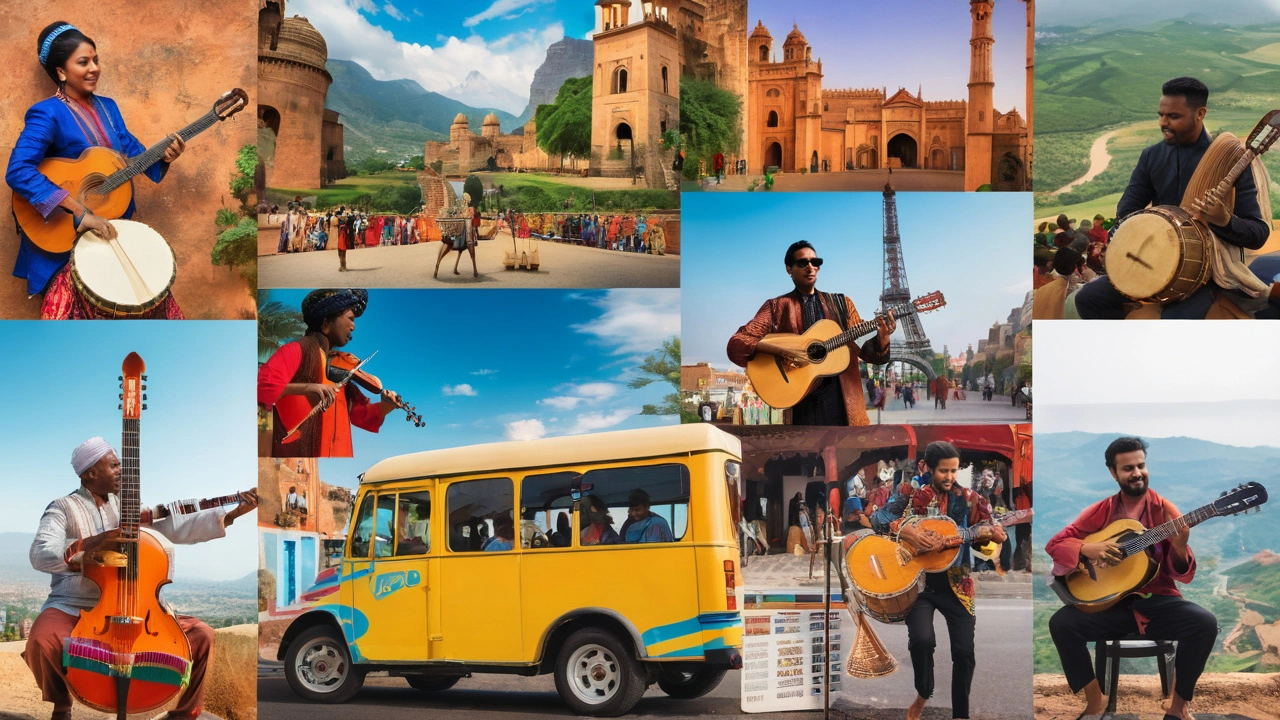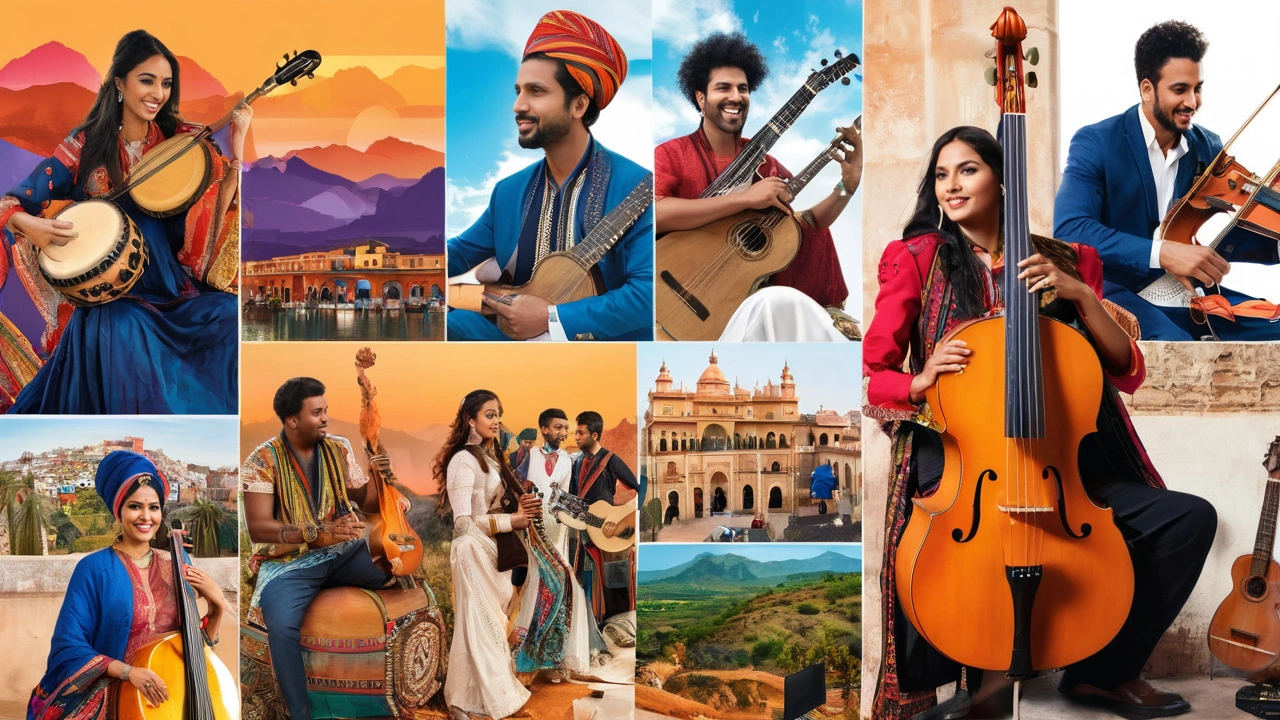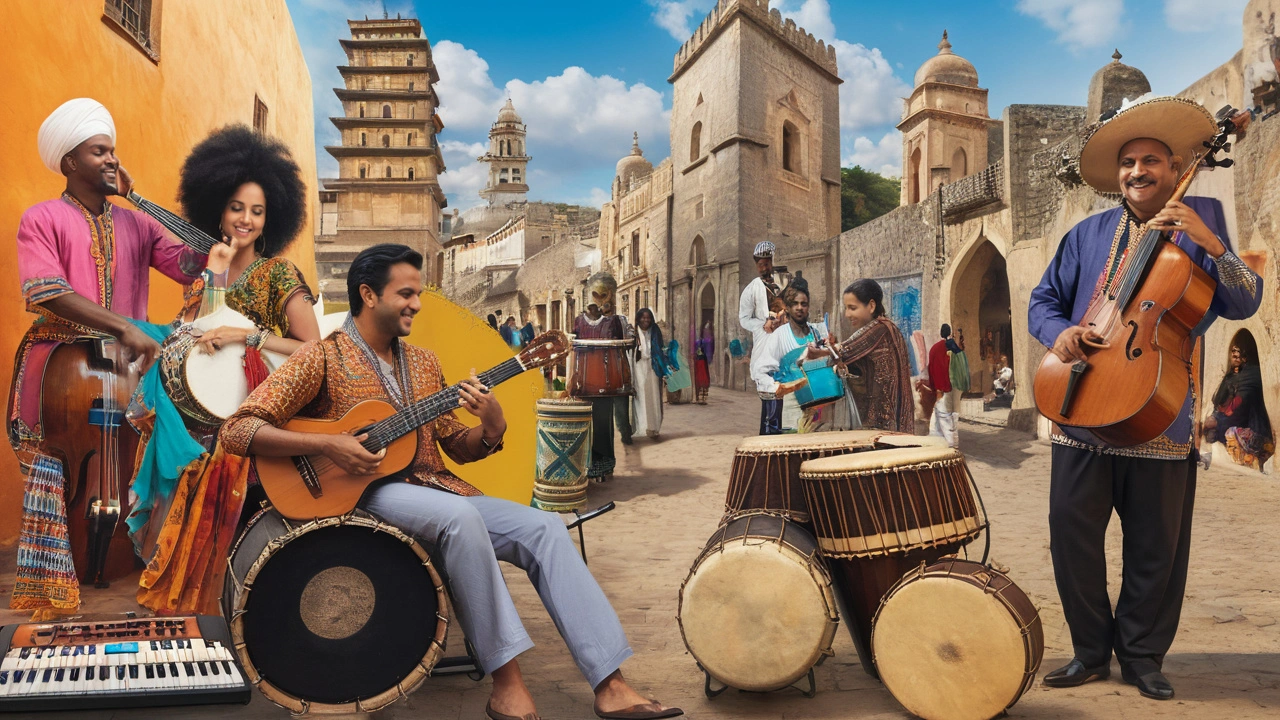Music is a universal language that transcends borders, uniting people from various cultures and backgrounds. It has the power to evoke emotions, tell stories, and create bonds. When you listen to music from different parts of the world, you embark on a journey that introduces you to new rhythms, instruments, and styles.
In this article, we'll explore some of the most intriguing music genres from around the globe. Let's take a closer look at how different cultures express themselves through their unique sounds and musical traditions.
- Introduction to Global Music
- African Rhythms and Sounds
- Asian Musical Traditions
- European Classical Influences
- American Music Evolution
Introduction to Global Music
When you think about music, it is fascinating to realize how its reach extends globally, crossing continents and uniting people from all walks of life. Music is more than just sounds; it's a representation of cultural identity, historical narratives, and social contexts. Each region of the world boasts a distinctive style of music that reflects its cultural roots.
Tuning into traditional African rhythms, serene Asian melodies, energetic European beats, or passionate Latin American tunes reveals not just entertainment but also the heartbeat of a community. Whether it's the rhythmic patterns of Latin America or the spiritual chants of Asia, these genres offer insights into the lives and histories of the people who create them. This makes exploring global music an enriching experience.
One of the striking aspects of global music is how it showcases the diversity of musical instruments. In Africa, drums like the djembe take center stage, while in India, the sitar produces intricate melodies. The native sounds of the didgeridoo, resonating from Australia, add another layer of depth to this musical journey. Each instrument carries centuries of tradition and craftsmanship.
The influences of music travel through time as well. Historical trade routes, such as the Silk Road, played a significant role in the cross-cultural exchange of musical ideas, instruments, and styles. For instance, the gypsy music moving through Europe owes much to these ancient interactions. Remarkable symphonies and operas from Europe highlight how much cultural exchange has impacted artistic expressions.
Examining traditional folk music also reveals much about a culture's traditions and values. Songs passed down through generations often hold stories of myths, legends, and historical events, embedded within their melodies and lyrics. These traditional tunes are more than music; they are living histories. Modern musicians often draw inspiration from these traditional roots, creating a fusion that both respects and rejuvenates ancient sounds.
"Music can change the world because it can change people," said Bono of U2, highlighting the profound impact music can have on human lives across different cultures.
Moreover, the advent of the internet has revolutionized access to global music. Platforms like YouTube and Spotify allow you to explore an extensive range of genres from virtually any part of the world. This increased accessibility enables a more comprehensive understanding and appreciation of different musical traditions. Listeners can dive into anything from Japanese Koto music to Brazilian Samba with just a few clicks.
The adaptability and resilience of global music are truly astounding. Even in the face of modern challenges, traditional music continues to thrive and adapt. Many contemporary artists seamlessly blend native instruments with modern production techniques, creating innovative music that still respects its roots. This harmonious blend of old and new ensures that traditional music remains relevant in today's dynamic musical landscape.
As you explore global music, pay attention to not just the sounds but also the stories behind them. Every genre has its journey, and every instrument has its personality. Embracing these diverse sounds broadens your musical horizons and deepens your understanding of the world. After all, in the words of renowned composer Leonard Bernstein, "Music can name the unnameable and communicate the unknowable."
African Rhythms and Sounds
Africa is often referred to as the cradle of humanity, and its music serves as a profound testament to its deep cultural roots. African music is characterized by its complex rhythms, rich oral traditions, and the use of a variety of instruments that are often crafted from natural materials found in the region. One of the most distinctive elements of African music is its use of polyrhythms – the simultaneous combination of contrasting rhythms, which creates a textured and dynamic sound. This can be heard in many traditional ceremonies, festivals, and daily activities across the continent.
The djembe, an iconic drum originating from West Africa, is one of the most well-known African instruments. The djembe is not just a drum; it serves as a means of communication and has been used for centuries to bring communities together. The player strikes the drum in different ways to produce a variety of tones. It's common to see the djembe in performances alongside other traditional instruments like the kora, a stringed instrument from the Mandinka people, and the balafon, an ancestor of the modern xylophone.
Interestingly, the rhythms and sounds of Africa have greatly influenced many modern music genres around the world. Jazz, for example, has its roots in the African-American communities of New Orleans, drawing heavily from the African musical traditions. The genre's use of improvisation, syncopation, and blue notes can trace its lineage back to the rhythmic patterns and modes found in African music. Similarly, Afrobeat, pioneered by Fela Kuti in Nigeria, blends traditional African music with jazz, funk, and highlife to create a uniquely vibrant and highly danceable sound.
African music is also diverse across the continent. For instance, West African music often emphasizes drum ensembles and vocal harmonies, while East African music, influenced by Arab traders, features instruments like the oud and the nyatiti. In Southern Africa, genres like mbube and kwaito combine indigenous sounds with contemporary influences, creating an ever-evolving musical landscape.
Notable musicians like Miriam Makeba, known as “Mama Africa,” and Ali Farka Touré have brought African music to the global stage, showcasing its rich heritage and universal appeal. Makeba's music, infused with political activism, played a significant role in the anti-apartheid movement, demonstrating the power of music as a means of social change. Touré, often referred to as the “Bluesman of Africa,” blended traditional Malian music with American blues, drawing a seamless connection between the two.
As modern technology continues to evolve, so does African music. Today, genres like Afrobeats, which originated in Nigeria, are taking the world by storm. Artists like Burna Boy and Wizkid are not only local stars but have also gained international acclaim. Their music, characterized by catchy hooks and infectious rhythms, maintains a strong connection to traditional African sounds while appealing to contemporary global audiences.
As we explore the rich tapestry of global music, it's clear that African rhythms and sounds play a foundational role. Whether through traditional instruments, influential genres, or modern interpretations, the spirit and vitality of African music continue to resonate and inspire people all over the world.

Asian Musical Traditions
Asia is a continent of immense cultural diversity, and this is reflected in its music. From the haunting melodies of the Chinese guqin to the energetic rhythms of Indian tabla, Asian music is a treasure trove of unique sounds and instruments. Each country within Asia offers its own distinct musical traditions that have been passed down through generations.
In China, traditional music often revolves around instruments such as the pipa, erhu, and guzheng. These instruments produce melodies that are both intricate and soothing, often associated with ancient Chinese poetry and philosophy. A hallmark of Chinese traditional music is the use of the pentatonic scale, which gives it a characteristic sound that is immediately recognizable.
India boasts one of the oldest and richest music traditions in the world, with classical music being divided into two major styles: Hindustani in the north and Carnatic in the south. The complexity of Indian classical music lies in its raga system, which consists of various scales and modes that a musician improvises upon. Instruments like the sitar, tabla, and veena are prominent in this genre. The spiritual and meditative aspects of Indian music are profound, making it not just an art form but a pathway to transcendence.
Japanese music, known for its minimalistic and subtle beauty, has instruments like the koto and shamisen at its core. These instruments are often played in ensemble settings or as solo performances, creating a serene and introspective atmosphere. Gagaku, a type of classical Japanese music, is still performed at the Imperial Court and offers insight into Japan's storied past. The influence of nature is a recurrent theme in Japanese compositions, often mirroring the country's seasonal changes.
"Music is a higher revelation than all wisdom and philosophy." - Ludwig van Beethoven
Thailand's traditional music is equally captivating, characterized by its use of the ranat (xylophone) and saw (fiddle). Thai music often incorporates rhythmic and melodic patterns that are both lively and graceful, resonating with the country's rich cultural heritage. Whether it is played in royal ceremonies or local festivals, Thai music always brings a sense of joy and community.
Another fascinating aspect of Asian music is the influence of regional folk traditions. The Vietnamese Dan Bau, a one-stringed instrument, creates music that is both melancholic and poetic, reflecting the spirit of the Vietnamese people. Mongolian throat singing, known as khoomei, allows singers to produce multiple pitches simultaneously, a mesmerizing skill that has been practiced for centuries.
European Classical Influences
European classical music has had a profound impact on music history and culture across the world. This genre, characterized by its complexity, sophistication, and emotional depth, originated in the traditions of Western liturgical and secular music. Its roots stretch back to the Medieval and Renaissance periods, surging during the Baroque, Classical, and Romantic eras.
The Baroque period (1600-1750) introduced intricate musical forms and elaborate ornamentation. Composers like Johann Sebastian Bach and George Frideric Handel are iconic figures from this era. Bach’s compositions are admired for their intellectual depth and technical command. His work, such as the “Brandenburg Concertos,” remains a cornerstone in classical music.
Transitioning to the Classical period (1750-1820), the emphasis shifted towards clarity, balance, and form. The music of Wolfgang Amadeus Mozart and Ludwig van Beethoven symbolizes this era. Mozart's “Eine kleine Nachtmusik” is praised for its melodic beauty and symmetrical form, while Beethoven’s “Symphony No. 9” is celebrated for its innovation and emotional power. Beethoven, often considered a bridge between the Classical and Romantic periods, expanded the scope of symphonic music.
During the Romantic era (1800-1910), composers sought to express deeper emotions and explore new structures and tonalities. This period saw the rise of virtuoso performances and elaborate compositions. Pyotr Ilyich Tchaikovsky’s ballets, like “Swan Lake,” offer a brilliant example of Romanticism’s dramatic flair and emotional intensity. Frédéric Chopin’s piano works, with their lyrical and often melancholic qualities, also exemplify Romantic ideals.
European classical music also includes a rich array of operatic works. Italian opera, with figures like Giuseppe Verdi and Giacomo Puccini, revolved around passionate, often tragic narratives. Puccini’s “La Bohème,” an opera about love and poverty in Paris, continues to enchant audiences with its poignant melodies and relatable characters. Meanwhile, German opera, led by Richard Wagner, emphasized mythology and leitmotifs, as seen in Wagner's monumental “Ring Cycle.”
"Classical music is the kind we keep thinking will turn into a tune." - Kin Hubbard
The influence of European classical music extends beyond its own shores. It was pivotal in shaping various modern genres and continues to be an essential part of music education worldwide. Learning about classical music's forms, theories, and compositions provides invaluable insights into the fabric of Western music aesthetics.
Instruments, such as the piano, violin, and cello, gained popularity through classical music and remain predominant in orchestras and solo performances today. The development of the symphony, sonata, and concerto forms has been integral to this genre's evolution. The symphony is particularly notable, with composers continually experimenting with structure and expression to create compelling narratives and rich soundscapes. Concertos, often featuring solo instruments with orchestral accompaniment, highlight the virtuosity of both the soloist and the ensemble.

American Music Evolution
The story of American music is one of continuous transformation and rich diversity. From its roots in Native American music, European melodic traditions, and African rhythms, music in America has evolved into a complex tapestry that mirrors the cultural melting pot of the nation itself.
In the early 20th century, the emergence of **blues music** in the Mississippi Delta was a pivotal moment. This genre, characterized by its use of blue notes and expressive depth, laid the groundwork for much of modern American music. Blues legends such as Robert Johnson and B.B. King are still revered for their contributions. Around this time, **jazz** was also developing in New Orleans. Jazz’s intricate improvisations and rhythmic innovations soon captivated audiences worldwide, led by icons like Louis Armstrong and Duke Ellington.
Moving into the mid-20th century, America saw the explosion of **rock ‘n’ roll**. It began in the 1950s with pioneers such as Chuck Berry and Elvis Presley, who brought a new energy that captivated the younger generation. Rock ‘n’ roll's blend of rhythm and blues, country, and gospel became the soundtrack of a generation. The 1960s and 1970s further expanded the genre with musicians like The Beatles, The Rolling Stones, and Jimi Hendrix, who pushed the boundaries and set the stage for its global dominance.
Parallel to rock's rise, the 1960s also saw the birth of **soul music** in cities like Detroit and Memphis. Motown Records, founded by Berry Gordy, was instrumental in popularizing this genre, producing hits from legends like Marvin Gaye, Diana Ross, and Stevie Wonder. Soul music’s emotional depth and powerful vocals continue to resonate to this day.
As American society continued to evolve, so did its music. The late 1970s and early 1980s marked the advent of **hip-hop** in the Bronx. This genre, combining rhythmic speech patterns with DJing, breakdancing, and graffiti art, represented the voice of urban youth. Early pioneers such as Grandmaster Flash and The Sugarhill Gang laid the foundation, with later artists like Tupac Shakur and The Notorious B.I.G. bringing hip-hop into mainstream consciousness. Today, hip-hop is a dominant force in global music, influencing fashion, language, and culture.
Beyond the mainstream genres, America is also a hub for various niche genres. The rise of ***electronic dance music (EDM)*** in the 1980s, for example, brought entirely new sounds and experiences to clubs and festivals. DJs and producers such as Deadmau5 and Skrillex have taken EDM to new heights, blending it with other genres and showcasing its versatility.
Analyzing the evolution of American music reveals more than just changes in sound. It provides insights into social movements, technological innovations, and cultural shifts. Music is woven into the fabric of American life, reflecting its complexities and diversities. As Quincy Jones once stated, “Music is the soundtrack of your life.”
“Music is the soundtrack of your life.” — Quincy Jones






